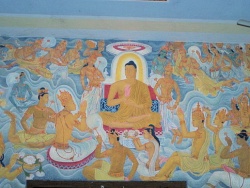Paticcasamuppada
Paticcasamuppāda: 'Dependent Origination', is the doctrine of the conditionality of all physical and psychical phenomena, a doctrine which, together with that of impersonality anatta, forms the indispensable condition for the real understanding and realization of the teaching of the Buddha.
It shows the conditionality and dependent nature of that uninterrupted flux of many physical and psychical phenomena of existence conventionally called the ego, or man, or animal, etc.
Whereas the doctrine of impersonality, or anatta proceeds analytically, by splitting existence up into the ultimate constituent parts, into mere empty, unsubstantial phenomena or elements,
the doctrine of dependent origination, on the other hand, proceeds synthetically, by showing that all these phenomena are, in some way or other, conditionally related with each other.
In fact, the entire Abhidhamma Pitaka, as a whole, treats really of nothing but just these two doctrines: phenomenality - implying impersonality and conditionality of all existence.
The former or analytical method is applied in Dhammasangani, the first book of the Abhidhamma Pitaka; the latter or synthetical method, in Patthāna, the last book of the Abhidhamma Pitaka.
For a synopsis of these two works, see: Guide I and VII.
Though this subject has been very frequently treated by Western authors, by far most of them have completely misunderstood the true meaning and purpose of the doctrine of dependent origination, and even the 12 terms themselves have often been rendered wrongly.
The formula of dependent origination runs as follows:
1. avijiā-paccayā sankhārā Through ignorance are conditioned the sankhāras,; i.e. the rebirth-producing intentions cetanā or 'kammic-constructions'.
2. sankhāra-paccayā viññānam Through the kammic-constructions in the past life is conditioned consciousness in the present life
3. viññāna-paccayā nāma-rūpam Through consciousness are conditioned the mental and physical phenomena nāma-rūpa i.e. that which makes up our so-called individual existence.
4. nāma-rūpa-paccayā salāyatanam Through the mental and physical phenomena are conditioned the 6 bases,; i.e. the 5 physical sense-organs, and consciousness as the sixth.
5. salāyatana-paccayā phasso Through the six sense sources is conditioned the sensorial mental contact
6. phassa-paccayā vedanā Through the contact is conditioned feeling
7. vedanā-paccayā tanhā Through feeling is conditioned craving
8. tanhā-paccayā upādānam Through craving is conditioned clinging
9. upādāna-paccayā bhavo Through clinging is conditioned the process of becoming,; consisting in the active and the passive life process, i.e. the rebirth-producing kamma-making kamma-bhava and, as its result, the rebirth-process upapatti-bhava.
10. Bhava-paccayā jāti Through the rebirth-producing kamma-process of becoming is conditioned rebirth
11. jāti-paccayā jarāmaranam etc.:;Through rebirth are conditioned old age and death sorrow, lamentation, pain, grief and despair. Thus arises this whole mass of suffering again in the future.
